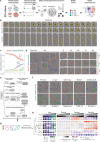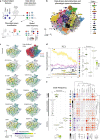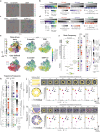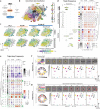Traject3d allows label-free identification of distinct co-occurring phenotypes within 3D culture by live imaging
- PMID: 36085324
- PMCID: PMC9463449
- DOI: 10.1038/s41467-022-32958-x
Traject3d allows label-free identification of distinct co-occurring phenotypes within 3D culture by live imaging
Abstract
Single cell profiling by genetic, proteomic and imaging methods has expanded the ability to identify programmes regulating distinct cell states. The 3-dimensional (3D) culture of cells or tissue fragments provides a system to study how such states contribute to multicellular morphogenesis. Whether cells plated into 3D cultures give rise to a singular phenotype or whether multiple biologically distinct phenotypes arise in parallel is largely unknown due to a lack of tools to detect such heterogeneity. Here we develop Traject3d (Trajectory identification in 3D), a method for identifying heterogeneous states in 3D culture and how these give rise to distinct phenotypes over time, from label-free multi-day time-lapse imaging. We use this to characterise the temporal landscape of morphological states of cancer cell lines, varying in metastatic potential and drug resistance, and use this information to identify drug combinations that inhibit such heterogeneity. Traject3d is therefore an important companion to other single-cell technologies by facilitating real-time identification via live imaging of how distinct states can lead to alternate phenotypes that occur in parallel in 3D culture.
© 2022. The Author(s).
Conflict of interest statement
E.C.F. was supported by a University of Glasgow Industrial Partnership PhD scheme co-funded by Essen Bioscience, Sartorius Group. All other authors have no competing interests.
Figures






Similar articles
-
Advanced technological tools to study multidrug resistance in cancer.Drug Resist Updat. 2020 Jan;48:100658. doi: 10.1016/j.drup.2019.100658. Epub 2019 Oct 17. Drug Resist Updat. 2020. PMID: 31678863 Review.
-
Erratum: High-Throughput Identification of Resistance to Pseudomonas syringae pv. Tomato in Tomato using Seedling Flood Assay.J Vis Exp. 2023 Oct 18;(200). doi: 10.3791/6576. J Vis Exp. 2023. PMID: 37851522
-
Autofluorescence Imaging of 3D Tumor-Macrophage Microscale Cultures Resolves Spatial and Temporal Dynamics of Macrophage Metabolism.Cancer Res. 2020 Dec 1;80(23):5408-5423. doi: 10.1158/0008-5472.CAN-20-0831. Epub 2020 Oct 22. Cancer Res. 2020. PMID: 33093167 Free PMC article.
-
Simultaneous 2D and 3D cell culture array for multicellular geometry, drug discovery and tumor microenvironment reconstruction.Biofabrication. 2021 Aug 31;13(4). doi: 10.1088/1758-5090/ac1ea8. Biofabrication. 2021. PMID: 34407511
-
Folic acid supplementation and malaria susceptibility and severity among people taking antifolate antimalarial drugs in endemic areas.Cochrane Database Syst Rev. 2022 Feb 1;2(2022):CD014217. doi: 10.1002/14651858.CD014217. Cochrane Database Syst Rev. 2022. PMID: 36321557 Free PMC article.
Cited by
-
CellTracksColab is a platform that enables compilation, analysis, and exploration of cell tracking data.PLoS Biol. 2024 Aug 8;22(8):e3002740. doi: 10.1371/journal.pbio.3002740. eCollection 2024 Aug. PLoS Biol. 2024. PMID: 39116189 Free PMC article.
-
Bridging live-cell imaging and next-generation cancer treatment.Nat Rev Cancer. 2023 Nov;23(11):731-745. doi: 10.1038/s41568-023-00610-5. Epub 2023 Sep 13. Nat Rev Cancer. 2023. PMID: 37704740 Review.
-
Traject3d for studying 3D cellular heterogeneity.Nat Rev Cancer. 2023 Sep;23(9):577. doi: 10.1038/s41568-023-00592-4. Nat Rev Cancer. 2023. PMID: 37268781 No abstract available.
-
BEHAV3D: a 3D live imaging platform for comprehensive analysis of engineered T cell behavior and tumor response.Nat Protoc. 2024 Jul;19(7):2052-2084. doi: 10.1038/s41596-024-00972-6. Epub 2024 Mar 19. Nat Protoc. 2024. PMID: 38504137
-
CellRomeR: an R package for clustering cell migration phenotypes from microscopy data.Bioinform Adv. 2025 Apr 4;5(1):vbaf069. doi: 10.1093/bioadv/vbaf069. eCollection 2025. Bioinform Adv. 2025. PMID: 40330627 Free PMC article.
References
Publication types
MeSH terms
Grants and funding
- 29801/CRUK_/Cancer Research UK/United Kingdom
- 29996/CRUK_/Cancer Research UK/United Kingdom
- A28223/CRUK_/Cancer Research UK/United Kingdom
- A29996/CRUK_/Cancer Research UK/United Kingdom
- C7932/A25170/CRUK_/Cancer Research UK/United Kingdom
- MR/T040769/1/MRC_/Medical Research Council/United Kingdom
- A22904/CRUK_/Cancer Research UK/United Kingdom
- C596/A19481/CRUK_/Cancer Research UK/United Kingdom
- MR/L017997/1/MRC_/Medical Research Council/United Kingdom
- A26825/CRUK_/Cancer Research UK/United Kingdom
- A29801/CRUK_/Cancer Research UK/United Kingdom
- A25233/CRUK_/Cancer Research UK/United Kingdom
- K99 CA163535/CA/NCI NIH HHS/United States
- C596/A17196/CRUK_/Cancer Research UK/United Kingdom
- A31287/CRUK_/Cancer Research UK/United Kingdom
LinkOut - more resources
Full Text Sources
Medical

